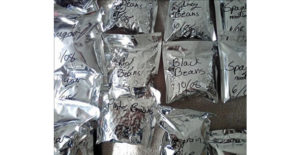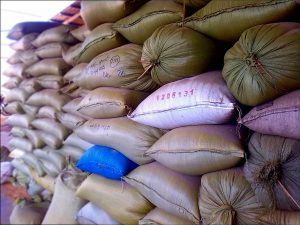Emergency Food Storage for Natural Disasters

No one is to blame.
We are living in a world of hyper convenience where, only recently, through the gift of information and flow of technology have we come to understand the severity of the threats that we face. We see hurricanes, war and terrorism in HD now.
There was a time when those who prepared for disaster were considered paranoid. There was a stigma that followed them and most kept quiet, concerned about things like OPSEC or operational security.
However, we are now studying the sun and we understand the power of a solar induced EMP.
There seems to be an ever-looming issue of ECONOMY and how it might all crumble around us one day. While just 10 years ago people were asleep at the wheel of disaster preparedness, things are changing. The average person is looking for answers.
The Confusion of Neophyte Emergency Preparedness
At The Prepper Broadcasting Network, we talk to a lot of people. We have a vast audience of listeners and readers that ask questions and even give answers!
It’s a full spectrum. For those getting started its nearly impossible to understand where to start! That has a lot to do with massive amount of content out there, the products being sold, and the marketing campaigns used to sell those items, often by using that content.
To some, it might seem like silver is the most important purchase a person can make. It’s a hedge against a failing dollar.
Others take a tactical route. Its guns, ammo and chest rigs for this type of person.
There are only two things to concern yourself with when it comes to basic emergency preparedness. Those two things are paramount. I will borrow a phrase but with guns and no food you are “securely starving.”
1. Water
2. Food
For the new prepper this should be your earliest focus. We are going to look at beginners food storage but we also have an article on water storage and filtration.
The Basics of Emergency Food Storage for Disasters
There are many options when it comes to the basics of emergency food storage for disasters. I know, there are just a lot of options in our world! It’s all confusing if you are starting from zero.
I would argue that one of the big reasons the average person doesn’t get into preparedness is because they are overwhelmed by another mountain of STUFF to learn.
Its hard enough. Life is simply over scheduled and underappreciated. Who really wants to do any hard work with hard consequence?
However, you should at least know what types of foods are out there.
FREEZE DRIED FOOD STORAGE
Several companies out there are preparing emergency food storage and using the process of freeze drying. They package this product in a variety of ways from #10 cans to 5 gallon buckets.
If you have the money, these prepacked base ingredients in 5 gallon buckets can be very effective for building that 3 month, 6 month or even years’ worth of food storage.
These are often base ingredients like rice, beans, wheat, oats, pasta and things like that. Your food storage plan should consist of plenty base ingredients and the knowledge of how to prepare them.
FREEZE DRIED MEALS
This is about the most expensive means of storing food. You might recognize brands like Mountain House and Backpackers Pantry. These are, most often, premade meals that feed about two people.
These are not the best means of storing for long term disaster recovery, but they are cool to have around if you have 72 hour power outage or if you fancy yourself an outdoorsman.
CANNED AND BOXED DRY GOODS
If you are not interested in storing dried long term food storage or freeze-dried foods, you might seek answers at the supermarket. You can store canned goods and boxed dry foods like pasta or boxed meals.
Dry goods can be purchased with a few extra dollars each week and they accrue quickly.
The Best Answer to Emergency Food Storage for Disasters
The very best answer for emergency food storage is to do it yourself. You might think that sounds impossible, but you can create exactly what the food storage companies sell to you.
This way you know where the food came from, you know when it was packed, and you know how it was packed. It gives you another layer of protection against hunger. It’s rare that people crack these buckets of dried food storage that come from these food storage companies. Who knows how their processes will hold up 10 years after you purchase?
If you need that food in 10 years you are going to be dependent upon it.
You need three items, on hand, if you are going to bucket up your own food.
• 5 Gallon Buckets
• Mylar Bags
• Oxygen Absorbers
Ideally, you will buy your foods in bulk and that will get you the most for your money. If you are nervous about this, don’t be. A Sam’s Club membership runs $60 a year and you will get 50lb bags of rice for $20! That’s about as good a start as any.
Rice is just one example of the great food storage deals that you can get at these club membership locations.
The Mylar bags are filled with food and an oxygen absorber is added. Then the mylar bag is heat sealed. You can buy a heat sealer or just a hair straightener. Be thorough in this process as air is the killer of food storage.
You cannot just add oxygen absorbers to food without first figuring some things out. You need know how much and what type of food your storing. Then use the right size O2 absorber for the job.
Below I have a chart created over at www.readynutrition.com
Oxygen Absorber Size Requirements
1-quart pouch (8″ x 8″)—947 CCs) #10 can (0.82 gallon)—3,910 CCs) 5-gallon bucket—18,942 CCs 6-gallon bucket—22,730 CCs
Flour, pancake mix, fine powders 50–100 cc 200–300 cc 750 cc 1000 cc
Sugar, salt, dry milk 50–100 cc 200–300 cc 750 cc 1000 cc
Rice, grains (wheat berries, oats, etc.) 50–100 cc 200–300 cc 750–1,000 cc 1000–1,500 cc
Dried beans 100–150 cc 300–500 cc 1,000 cc 1,500 cc
Pasta 100–200 cc 300–600 cc 1,000–1,500 cc 1,500–2,000 cc
Once your oxygen absorbers are added and your bags sealed you fill up buckets with that food. Now you have your own long term food storage to help you through disasters. Just be sure you mark them appropriately.
If you want to see this entire process from start to finish, in video format, check out our Patreon. We have a great video. You will learn how to use 1-gallon mylar bags and why they are effective.
How Much Food Do I Store?
Now that you understand the process and the types of food to store, its time to talk numbers.
How much food are your trying to store? Well, that has to do with a few different things.
1. Number people are in your family?
2. How many calories per person/per day are you planning for?
3. Are there extra people coming?
4. Duration? (3/6/12 months?)
These are all your decisions and ultimately, if a serious disaster befalls you and yours, you will live and die by these decisions.
Let’s talk about a common food storage situation so you can get one example. We can prepare for a family of four for 1 month. That is a good goal and its one that is not to far out of reach for the average person, if you buy your food right.
No matter who you are preparing for, whether 2 years old or 20, they need 2000 calories a day. Of course, this is more than you need. In all endeavors involving food and thought there is but one conclusion: just put up more food.
So, a family of four is going to require 8000 calories per day
That’s 240,000 calories per month.
50lbs of rice will get you 80,000 calories! Of course, you are not going to eat rice only, but it gives you an idea of how quickly you can add these things up. Add 25lbs of black beans and you are going to be crushing that goal of 1 months in no time.
From here you can build up to a years’ worth of food, if you want to.
Don’t forget the buckets, O2 absorbers, and mylar bags!
Conclusion
While growing food should not be something you stop doing because of emergency food storage, your garden can never do what rice and beans do. For true long term disaster, you are going to need long term food storage.
You need to understand the process from start to finish and put up as much food as you can, the right way. Be sure your food is protected in 5-gallon buckets so that its there for you when you need it most.
This is well within your power and as we explored, well within your budget.
Most gardens are going to be a mere supplement to your food storage. Why? Because most people don’t have that kind of land anymore. The kind that feeds a family. You can also have poor yields or other circumstances that affect that garden.
Emergency food storage is safe, inside the home, behind locked doors. Rely on it and start your stockpile today.






8 Responses
Thanks for the guidelines for the O2 absorbers! Had not seen the info broken down into a great chart before. Will be adding the guidelines to the ol’ emergency binder for sure!
Well, I cannot take all the credit. It was a resource from readynutrition.com but I guess putting it in front of you counts a little.
Oxygen absorbers should never be used with sugar.
I personally believe that long term storage foods are the best way to go for preparedness, versatility, and good nutrition. However, if you do not know how to use them, you and your family will not like them, and you will be hungry. Prep School Daily (dot blogspot dot com) offers a wealth of information on using long term storage foods every day and making them taste good.
Great info and motive here Jennifer. Didn’t know that about sugar. Thanks for the resource.
I like to use popcorn cans I find at Good Will stores they are vermin proof where plastic buckets are not.
Metal is always a good option, right? I like the idea. Keep storing food.
[…] Research & References of Emergency Food Storage for Natural Disasters|A&C Accounting And Tax Services Source […]
[…] Research & References of Emergency Food Storage for Natural Disasters|A&C Accounting And Tax Services Source […]